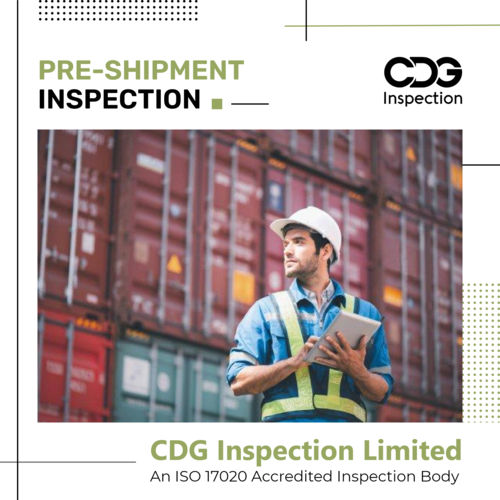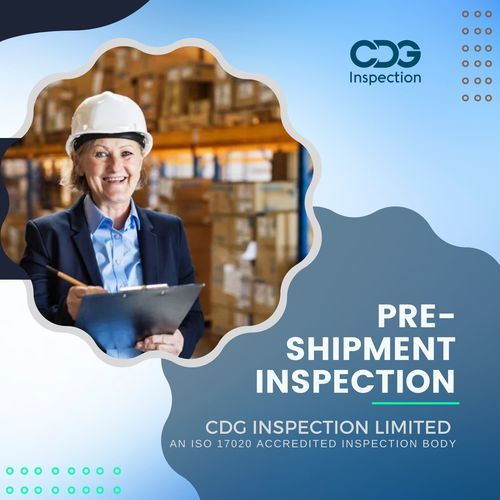Pre-Shipment Inspection in Bahadurgarh
Pre-Shipment Inspection in Bahadurgarh Trade Information
- Main Domestic Market
- All India
About Pre-Shipment Inspection in Bahadurgarh
CIL Provides Accredited Pre-Shipment Inspection Services in Bahadurgarh, Haryana, India.7 Important Steps in a Pre Shipment Inspection Procedure, A professional pre shipment inspection gives suppliers the assurance that their products are ready to be sent to their destination market. This procedure includes seven essential steps but before delving into them, lets recap the basics of pre shipment inspections. What is a Pre Shipment Inspection, A pre shipment inspection is a step taken by trade operators (buyers, suppliers, agencies) to inspect newly manufactured products before they are shipped for export or import. The purposes of a pre shipment inspection are to, Check the quantity and quality of the merchandise, Check products for any defects, Ensure products meet the safety requirements of the destination market, Issue report for import and billing. Pre shipment inspections were officially introduced in 1994 as an agreement to improve international trade standards under the General Agreement on Tariffs and Trade (GATT), which was later replaced by the World Trade Organisation (WTO). A number of obligations were included in the Agreement on Pre Shipment Inspection, stating that pre shipment investigations should be applied according to the following principles, Non discrimination, Transparency, Protection of confidential business information, Avoidance of delays, Price verification based on the price of identical or similar goods in the country of exportation, in which the exporter has the opportunity to explain the price charged. Inspection agencies establish appeals procedures, the findings of which are made available to other exporters. Accredited inspection agencies perform pre shipment inspections when production is at least 80 percent complete. This is your final opportunity to take corrective action before your production is shipped, making it an effective tool to safeguard your product against costly import risks. The pre shipment inspection typically covers, functionality, performance, durability, overall appearance, and dimensions. Following a successful pre shipment inspection, the agency issues an inspection report document which accompanies the consignment to its destination.7 Important Steps in a Pre Shipment Inspection Procedure. Step 1. Inspection Visit, Pre shipment inspections are carried out on site at the factory or production house. If the inspectors suspect that the products could contain restricted chemicals, they may advise further off site lab testing of those products. Step 2. Quantity Verification, The inspectors count the shipping cartons to verify the correct quantity. In addition, this step ensures that the correct number of products and boxes will be sent to the correct destination; therefore, the pre shipment inspection can be agreed upon between a buyer, a supplier, and a bank to initiate payment for a letter of credit. The packaging is also checked to verify that the correct packing materials are being used to ensure safe transportation, and that correct packaging labels are applied. Step 3. Random Selection, Professional pre shipment inspection services use the internationally recognized statistical sampling procedure ANSI ASQC Z1.4 (ISO2859 1).The acceptable number of defects in a batch before its rejected is defined with an Acceptance Quality Limit (AQL). The AQL varies depending on the type of product being evaluated, but the objective is to provide a balanced, unbiased view. Step 4. Cosmetic and Workmanship Check, The first thing an inspector looks at from the random selection is the overall workmanship of the finished products, to check for any immediately visible defects. Defects are typically classified as minor, major, or critical based on predetermined acceptable tolerance levels, which are usually agreed upon between the manufacturer and supplier during product development. Step 5. Conformity Verification, Quality control inspectors check product dimensions, material and construction, weight, colour, marking, and labelling. If the pre shipment inspection is for garments, the inspector checks whether correct sizes have been assigned to the shipment and that the sizes correspond with production dimensions and the labels. For other products, dimensions may be much more important, so this is when the dimensions of the finished product can be measured and compared with your original specifications. Step 6. Function and Safety Test, Function Testing for Garments, For garment, apparel and footwear inspections, the inspectors perform physical tests on the products to determine the strength of buttons, zippers, and other accessories with pull tests, fatigue tests, and stretch tests. Fabric density and composition tests determine the density or thickness of fabrics used in garment production. Special tools are used to measure fabric density. The quality control inspectors can also physically count the number of stitches per inch. A fabric that is tooth in or not dense enough could mean your manufacturer has used an inferior fabric or textile that wont stand up to normal wearing and washing.
Nationwide Coverage with Experienced Inspectors
Our inspection services extend beyond Bahadurgarh to cover the entire Indian region, with highly qualified inspectors possessing deep expertise in quality assurance. This ensures reliable and consistent inspection standards, irrespective of your shipment's destination.
Customizable and Comprehensive Inspection Solutions
Each inspection is tailored to your unique requirements, with a customizable checklist and the option for additional testing. Our process includes photographic documentation and sample pickup, addressing all aspects of product verification to enhance export compliance and mitigate shipment risks.
Transparent Reporting and Confidential Data Handling
Inspection reports are provided in both digital and hard copy formats, available in English and Hindi for broader accessibility. Client data and inspection findings are securely handled, maintaining strict confidentiality throughout the inspection cycle. Timely reporting and round-the-clock support keep you informed at every stage.
FAQ's of Pre-Shipment Inspection in Bahadurgarh:
Q: How does the pre-shipment inspection process work in Bahadurgarh?
A: Upon request, our experienced inspectors conduct on-site evaluations in Bahadurgarh before shipping. Inspections adhere to a customizable checklist, with photographic evidence, sample pickup, and additional testing available. Reports are delivered within 24 hours post-inspection.Q: What coverage area does the inspection service include?
A: We operate from Bahadurgarh but provide inspection services across Pan India, ensuring export shipments can be inspected at any location nationwide.Q: When is the inspection performed and how long does reporting take?
A: The inspection is carried out prior to the shipment's dispatch. Reports, prepared in your preferred language (English or Hindi), are typically available within 24 hours after the inspection is completed.Q: Where can I access the inspection report after the process?
A: Inspection reports are accessible in both digital and hard copy formats. You can receive them via email or request a physical copy, depending on your preference and location.Q: What benefits does photographic evidence offer during inspection?
A: Photographic documentation provides clear, objective proof of the product's condition and compliance, reducing disputes and facilitating smooth export shipment clearance.Q: Which industries and products are eligible for this inspection?
A: We serve all industries and products intended for export, ensuring they meet required standards and regulations before leaving India.Q: What payment methods and support options are available for clients?
A: Clients may pay online or offline, as per their convenience. We also offer 24x7 customer support to address any queries throughout the inspection process.
Tell us about your requirement

Price:
Quantity
Select Unit
- 50
- 100
- 200
- 250
- 500
- 1000+
Additional detail
Mobile number
Email

 Send Inquiry
Send Inquiry






 Send Inquiry
Send Inquiry Send SMS
Send SMS Call Me Free
Call Me Free